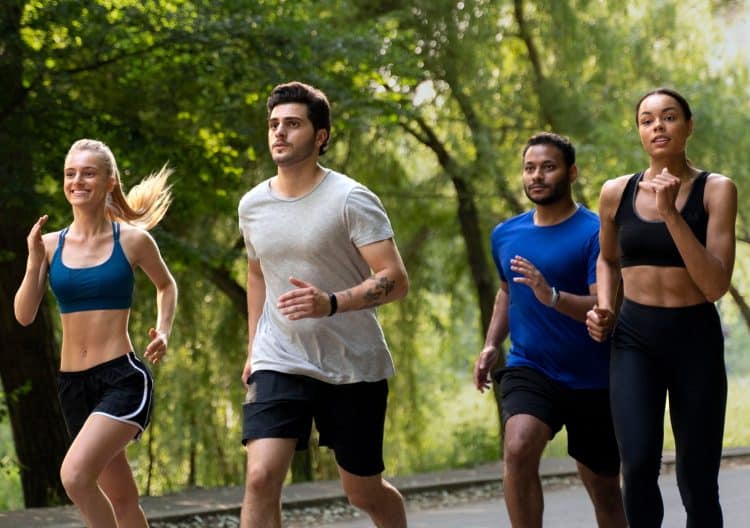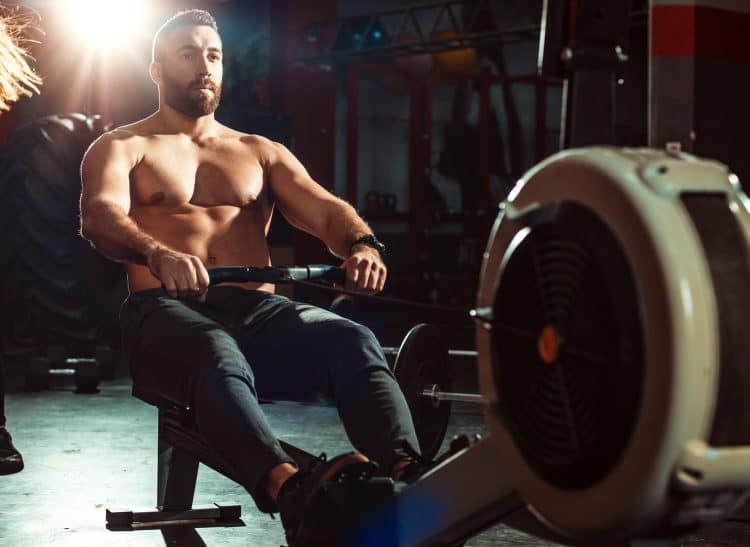Fitness can be defined as the successful adaptation to imposed demands, and your fitness is specific to the type of training you do. For example, powerlifters are very strong because they spend most of their training time lifting heavy weights. In contrast, runners have high levels of cardiovascular conditioning because most of their workouts are aerobic.
However, while it’s okay to be a fitness specialist, most people don’t need to emphasize one fitness component over all the others. In fact, they’d probably benefit from being more of a fitness all-rounder.
CrossFit has got a good handle on developing all-round fitness, and so too do MMA fighters and many branches of the military.
But, how do you measure fitness, and when are you fit enough?
While there is no perfect answer to these questions, there are certain standards that the average man should be able to achieve to be considered reasonably fit. Regardless of your “fitness specialty,” there are things that a healthy man should be able to do.
For this article, we’ve found ten fitness tests that most men (and many women) should aspire to. They cover a range of cardio and strength assessments selected to determine your all-round fitness. See how many you can pass, and then work on improving any poor results.
Level Up Your Fitness: Join our 💪 strong community in Fitness Volt Newsletter. Get daily inspiration, expert-backed workouts, nutrition tips, the latest in strength sports, and the support you need to reach your goals. Subscribe for free!
10 Fitness Tests for Every Man
The average man should be able to pass most of these fitness tests. Note that there is no scaling for age or body weight, and some tests are more challenging to pass than others, so you may not pass all of them without some additional training.
That said, they represent achievable standards that should be within the grasp of most male exercisers and provide a good goal to work towards.
If you can pass all these tests, you have an excellent level of all-round fitness!
Many of these fitness tests require an all-out effort, so make sure you warm up before you begin. Start with a few minutes of light cardio, followed by some dynamic mobility and flexibility exercises for your major muscles and joints.
Then, if necessary, practice the test to make sure you’re familiar with what you’re required to do. Finally, record your result and then try and beat your score next time.
1. Run a mile in nine minutes or less
Running is a convenient way to test your aerobic fitness, which is your ability to take in, transport, and utilize oxygen. Cardiovascular fitness is closely linked to cardiovascular health, so this is an important test to pass.
A one-mile run is a very accessible distance, and you don’t have to be a great long-distance runner to achieve it. However, it’s far enough to be challenging.
Think nine minutes sounds fast? Top athletes can cover the same distance in under four minutes, and elite marathoners run five-minutes per mile 26 times in a row. All you need to do is put one foot in front of the other and keep plodding!
Method:
Measure a one-mile course and then run it as fast as possible, preferably without stopping or walking. Alternatively, you can run a mile on a treadmill. Still, without wind resistance, this will be slightly easier, so set your treadmill to a 1% incline to counteract this.
2. Do 10 dead-hang pull-ups/chin-ups
Pull-ups and chin-ups are a great test of upper body pulling strength. They work your back and biceps. They’re also a good indicator of body weight, and if you can’t do ten pull-ups or chin-ups, there is a good chance you are overweight.
Why dead-hang pull-ups/chin-ups? Because pausing between reps eliminates momentum and prevents cheating. CrossFitters often use their legs to “kip” themselves up and do more reps. While this is an effective labor-saving strategy, it makes the exercise easier. Dead hang pull-ups and chin-ups are a better test of your fitness.
Method:
Hang from an overhead bar using a shoulder-width underhand grip (chin-up) or a slightly wider than shoulder-width overhand grip (pull-up). Your arms and body should be straight. Then, without kicking or swinging, bend your arms and pull your chin up and over the bar. Descend under control until your arms are straight again, and repeat.
3. 40 perfect push-ups
Where pull-ups and chin-ups are all about your upper body pulling muscles, push-ups test your pushing muscles, specifically your chest, triceps, and shoulders. Push-ups also involve your core muscles.
A lot of exercisers avoid push-ups and do bench presses instead, thinking that the humble push-up is only suitable for beginners. However, in some ways, push-ups are actually superior to bench presses, as you have to stabilize your entire body when you do them, which means they’re much more functional.
Regardless, most men should be able to come close to pumping out 40 perfect push-ups.
Method:
Kneel down and place your hands on the floor, so they’re about shoulder-width apart. Walk your feet back and into the push-up position, so your body and legs are straight. Brace your abs. Without lowering your hips or craning your neck, bend your arms until your chest lightly touches the floor. Push yourself back up to full arm extension and repeat.
4. Row 500 meters in under 100 seconds
Where running a mile in under nine minutes is an excellent test of aerobic fitness, 500 meters on a rowing machine in under 100 seconds is an assessment of your anaerobic fitness. Anaerobic means without oxygen.
While we could have used something like a 400-meter sprint, all-out running can be hard on your joints, and 400 meters is a real butt-kicker of a distance. We’d rather you didn’t hurt yourself to determine your fitness, and rowing is both safer and more convenient as you can do this test in the comfort of your gym.
Method:
Program your rower for 500 meters and set the resistance to level 6-10 so you’ve got plenty of weight to pull against. Rowing with good technique, try to cover the distance as fast as possible. Make a note of your performance and try to beat it next time.
5. Swim 400 meters without stopping
Level Up Your Fitness: Join our 💪 strong community in Fitness Volt Newsletter. Get daily inspiration, expert-backed workouts, nutrition tips, the latest in strength sports, and the support you need to reach your goals. Subscribe for free!
Swimming is not just a way to test your aerobic fitness – it’s also a skill that could save your life. As such, this isn’t a timed test but an assessment of your ability to swim 400 meters unaided and without stopping. Imagine you’ve fallen off a boat and have to swim to shore. Are you fit enough to save your own life?
Method:
In a pool, swim 400 meters/440 yards as fast as possible and without stopping. Use whatever stroke you wish, and feel free to change strokes whenever you want to. However, you must not touch the bottom of the pool at any time and can only touch the side of the pool for turns.
6. Squat your bodyweight
While a lot of lifters like to brag about how much weight they can bench press, strong legs are typically more useful. You can walk further, run faster, and jump higher with strong legs. As you get older, your leg strength will be the difference between being able to get out of your chair and walk upstairs or spending your days doing nothing but sitting and watching TV.
Squatting your bodyweight won’t win you any powerlifting competitions. Still, it’s a decent strength standard that most men should be able to achieve. Not being able to squat your own bodyweight could be an indicator that you’re too heavy as well as weak.
Method:
Using a power rack for safety, rest and hold your barbell across your upper back and stand with your feet about shoulder-width apart. Brace your abs. Bend your knees and descend until your thighs are parallel to the floor. Do not round your lower back. Stand back up and re-rack the bar.
7. Farmer’s walk your bodyweight for 50 meters
The ability to carry weights over various distances is an excellent test of full-body strength, endurance, and fitness. There are lots of different weighted carry exercises, but the farmer’s walk is one of the most straightforward. You can use a trap bar or pair of heavy dumbbells for this test.
Method:
Load up a trap bar or grab two dumbbells evenly sized that add up to your bodyweight. Measure out 50 meters/55 yards. Pick up the weights and walk steadily to cover the distance. Just focus on covering the distance – your time is not important. But, if you go too slowly, you may find that your grip fails before you have finished the course. Do not use lifting straps.
8. Plank for two minutes
While lengthy plank holds are not an effective use of your training time, being able to hold a plank for two minutes is a good test of your core endurance. A better way to plank for core strength is the Russian Kettlebell Challenge (RKC) method, which you can read all about here.
But, if you want to know if your core muscles are in good shape, this test will reveal the answer.
Method:
Lie on your front on the floor and rest on your elbows. Your forearms should be pointing forward. Clasp your hands if you wish. Lift your hips, so your body is straight, and your weight is supported on your feet and arms only. Maintain this position for as long as possible.
Related: Try This 30-Day Plank Challenge
9. Walk four miles in less than an hour
In the same way that a lot of exercisers dismiss push-ups in favor of the bench press, walking is often ignored as a form of exercise. That’s a shame because it’s actually one of the best things you can do for your fitness and health.
Walking, especially quickly, is an excellent way to develop low-end cardiovascular fitness and lower body muscular endurance. It’s also a potent fat burner. However, unlike running, walking very easy on your joints, so it’s safer for overweight exercisers.
Method:
Either plot a four-mile route on a map or use GPS to track your distance. Walk the four miles as quickly as you can without resorting to running. If possible, choose a reasonably flat route to ensure this test is as fair as possible. Alternatively, you can perform this test on a treadmill. However, to make up for the lack of wind resistance, you should set the incline to 1%.
10. Box jump 50% of your height
Box jumps are an excellent way to develop lower body muscle power. Power is your ability to generate force quickly and is an intrinsic part of almost every sport. The main advantage of box jumps over things like squat jumps is that there is less impact on landing, which makes this a much more joint-friendly activity.
Power tends to decline with age and is also very training-specific. If you don’t do a lot of power training, you can’t expect to have much muscle power. That said, even the average man should be able to box jump 50% of his height.
Method:
Starting with a knee-high box, do one box jump, rest a moment, and then increase the height of the platform by 2-4 inches. Continue until you can jump no higher, aiming to reach 50% of your height.
How to Get Better
Your fitness is dependent on the type of workout you do. So, if you did badly in any of the fitness tests described above, the best way to improve your performance is to include that test in your workouts, albeit in the form of training rather than just retesting yourself again and again.
For example, if you didn’t do very well at push-ups or pull-ups, make sure you include those exercises in your upper body workouts. Do push-ups and pull-ups several times a week to improve your performance faster. Gradually increase the number of reps you perform in training until you can achieve the prescribed standard.
If you struggled with the cardiovascular fitness tests (running, walking, rowing), include more cardio in your training week. For example, you could do strength training one day and run the next. Gradually increase your speed and distance as you get fitter.
Regardless of what you are trying to improve, continue training and retest your fitness every 4-6 weeks until you can meet and preferably surpass the levels outlined above. Some targets may take longer to reach than others, but every successful workout will take you a little closer. When you can pass all ten tests, you can consider yourself fit.
Wrapping Up
It doesn’t matter that you can squat 1000 pounds if running across the street puts you in danger of a heart attack. Similarly, you can’t really be considered fit if you can run 10k in less than 40 minutes but can’t do a single pull-up.
While it’s okay to specialize in specific types of exercise, unless you’re a championship contender, you still need to include other types of training in your workouts. Runners need to lift weights, weightlifters need to do cardio, and both need to stretch and mobilize. In most cases, including other types of training in your workouts will actually improve your performance and lower your risk of injury.
Use these tests to identify your fitness strengths and weaknesses, and then adapt your workouts to address what you’ve found lacking. This will make your workouts more varied and interesting and provide you with some new challenges to train for.












